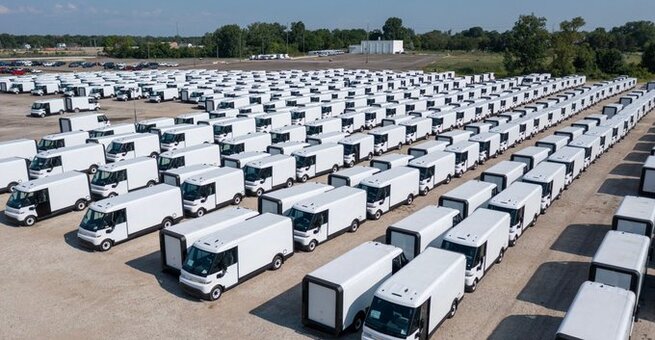Alerts

General Motors (GM) has confirmed it will end production of electric Chevy Brightdrop vans, marking a major shift in its electric commercial vehicle strategy. The announcement comes as slowing demand and the expiration of EV tax credits continue to impact the electric van market.
GM made the decision during its Q3 2025 earnings call, revealing that production at the CAMI Assembly Plant in Ingersoll, Ontario, will cease. This move highlights broader challenges facing the EV sector, particularly in commercial fleet sales.
According to GM CEO Mary Barra, the company made the decision after a careful evaluation of market conditions.
“This is not a decision we made lightly because of the impact on our employees,” Barra said.
She explained that the commercial electric van market has developed slower than expected, with changes to incentives and regulations making profitability difficult. Piles of unsold Brightdrop vans sitting on dealer lots across the U.S. and Canada further emphasize the demand slowdown.
Launched in 2021, Brightdrop was designed to give GM a competitive edge in the commercial EV market. The brand introduced two electric delivery vans along with fleet management software and smart delivery carts.
Partnerships with Walmart, FedEx, and other retailers initially generated excitement. However, after struggling to gain traction as a standalone brand, GM folded Brightdrop back into Chevrolet in 2023. The move aimed to leverage Chevy’s established dealer and service network — but even that wasn’t enough to revive sales.
The expiration of the $7,500 federal EV tax credit on September 30th delivered a major blow to Brightdrop’s sales. Commercial electric vehicles under 18,000 lbs — including the Brightdrop van — had qualified for the incentive.
Without it, the price gap between Brightdrop and competitors widened dramatically. Chevy’s vans started at around $74,000, compared to Ford’s E-Transit at $51,600. Despite offering longer range and premium features, Brightdrop’s high cost made it difficult for fleet buyers to justify the investment.
Even before the tax credit expired, GM was struggling to move inventory. Reports earlier in 2025 showed rows of unsold Brightdrop vans parked in lots in Flint, Michigan, and across Canada.
The commercial EV market has not expanded as rapidly as automakers expected. Many businesses are delaying electrification plans due to infrastructure costs, charging downtime, and uncertain regulations. Meanwhile, Ford, Rivian, and Mercedes-Benz have tightened their grip on the growing — yet cautious — delivery van market.
GM has stated it will assess the CAMI Assembly Plant for future opportunities. While the end of Brightdrop production is a setback, the facility could be repurposed for other EV or battery-related manufacturing in the future.
The automaker remains committed to its broader EV goals, even as specific models face discontinuation. Barra emphasized GM’s focus on long-term electric and autonomous innovation, noting that adjustments like these are part of “aligning resources with demand realities.”
Brightdrop’s rise and fall reflect both the promise and pitfalls of the commercial EV market. GM’s vision to electrify delivery fleets was ambitious, but timing, costs, and evolving policies have complicated execution.
As EV incentives fluctuate and infrastructure challenges persist, automakers are being forced to adapt quickly. The end of production of electric Chevy Brightdrop vans serves as a cautionary example of how even well-funded projects can struggle without steady market momentum.
While GM’s decision to halt Brightdrop production is significant, it doesn’t spell doom for electric delivery vehicles. Industry experts expect continued growth in the segment once costs drop and charging networks expand.
For now, GM appears focused on reshaping its EV lineup toward higher-volume passenger models like the Silverado EV and Blazer EV. Still, the lessons from Brightdrop may influence how automakers approach fleet electrification going forward.
GM’s move to end production of electric Chevy Brightdrop vans underscores a pivotal moment for commercial EVs. Slower-than-expected adoption, price competition, and the loss of federal incentives have reshaped automakers’ strategies.
As the market continues to evolve, Brightdrop’s story will stand as an important case study in the challenges of scaling electric fleets in a shifting policy and demand landscape.
𝗦𝗲𝗺𝗮𝘀𝗼𝗰𝗶𝗮𝗹 𝗶𝘀 𝘄𝗵𝗲𝗿𝗲 𝗿𝗲𝗮𝗹 𝗽𝗲𝗼𝗽𝗹𝗲 𝗰𝗼𝗻𝗻𝗲𝗰𝘁, 𝗴𝗿𝗼𝘄, 𝗮𝗻𝗱 𝗯𝗲𝗹𝗼𝗻𝗴. We’re more than just a social platform — from jobs and blogs to events and daily chats, we bring people and ideas together in one simple, meaningful space.